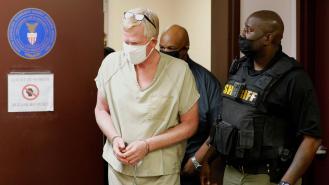
The Tetris deaths: Murder-suicide or Russian mob?
At one point in history, Tetris was the world’s best-selling game. The simple but addictive premise asked players to manipulate geometric shapes that fall down the screen. To this day, it’s one of the most famous exports from Russia.
Tetris was the brainchild of Alexey Pajitnov who developed it alongside Vladimir Pokhilko, a doctorate of psychology from Moscow University and junior researcher at the I.M. Sechenov First Moscow State Medical University. Vladimir became the first clinical psychologist to conduct experiments with the game and helped to launch it in the United States.
In 1991, Vladimir and Alexey moved from Russia to the United States to learn how to cater the game to the U.S. market. Their move was partly inspired by the collapse of the old system in the Soviet Union and the political turmoil that surrounded it.
They both moved to the San Francisco Bay area with their families and later that year, Vladimir told the author of Game Over, David Scheff: ‘I think it would be very good if our families came here and we stayed one, maybe two years. We could see what happens from here, where we would be safe.’
While in California, Vladimir and Alexey founded the San Francisco company, AnimaTek, which specialized in 3D graphics for computer animations. They had been inspired by the popularity of Tetris, which despite its success, had never made any profit for either man. Soviet authorities had ordered Alexey to hand over all the rights and he did out of fear of retaliation.
Eventually, the restrictions over Tetris expired, and they were returned to Alexey. He used the money to form the Tetris Company with a Russian oligarch, but Vladimir was not included in this new venture.
At around 3:30pm on 22nd September 1998, a 911 call came into police in Palo Alto. It was from a friend of Vladimir, who was only identified as Gunnadi. He reported that he had found Vladimir dead along with the bodies of his family. Police were directed to the home that Vladimir shared with his wife, Elena Fedotova, and their twelve-year-old son, Peter. It was a one-story home on Ferne Avenue, near San Antonio and Middlefield Roads.
Inside, they found the lifeless bodies of the family. Elena was dead in one room while Vladimir and Peter were in another. Elena and Peter had been repeatedly stabbed with a knife and struck on the head with a hammer. Both of them were in their beds, dressed in their pyjamas. As for Vladimir, he was found with a single knife wound to the throat that extended from one side to the other. ‘Obviously, there was a lot of anger. This was very violent,’ said Palo Alto Detective Lori Kratzner.
It was classified as a murder-suicide and the gruesome details dominated the headlines. Neighbours and friends said that they saw no signs of trouble with the family. They all described Vladimir and Elena as highly educated, entrepreneurial and very dedicated to one another and their son.
Vladimir’s former business partner, Alexey, commented: ‘It's really hard for me. I'm worried at what's happened, he's a good friend of mine. We are always in a very respectable business and work with computers and keep very far from anything even close to any kind of criminal stuff or sharp conflicts.’
An investigation into the family background ensued, and detectives learned that Vladimir’s business was in crisis. AnimaTek was a startup that had not yet made a profit and was deep in debt. In just a couple of years, Vladimir had managed to blow his way through around $3 million in venture capital.
Just the month beforehand, the company had laid off 45 of its 70 Russian employees. Vladimir had feared that everything he had worked hard to achieve was on the cusp of collapsing around him. A couple of days before the family was found dead, Vladimir had mistakenly feared that his financial backers would fire him as president.
He had met with two of his main investors, Gilman Louie and Henk Rogers, who recalled: ‘He said he thought he’d be fired, he’d been a failure, he should be the one held responsible.’ According to the investors, they tried to reassure Vladimir that his job was secure, that there was no intention to have him fired.
As Rogers recollected: ‘The business is a roller coaster. Things change, markets change. You have to adjust.’
Investigators believed that Vladimir had killed his family due to the financial strain and had then taken his own life. They discovered a note inside the home that had been written by Vladimir and indicated extreme anger and distress. It read in part: ‘I’ve been eaten alive. Vladimir. Just remember that I am exist. The davil.’ There were no bloodstains or bloody fingerprints on the paper.
Those who knew Vladimir, however, contended that he would never have harmed his wife and son. They said that business and money problems seemed an inadequate explanation for the three deaths.
Rogers commented: ‘I would expect him to have come to me and told me he was at wit's end if that's where he was. I would absolutely expect that of him.’ One of Peter’s teachers who asked not to be named also said: ‘It's so hard to believe. He loved his son so much, the way he talked about his accomplishments, in dancing or math or science… He was such a kind and tender father. It's a real tragedy.’
Just a couple of days after the grisly discovery, detectives announced that while they had initially ruled the deaths as a murder-suicide, they were not yet satisfied that they had all of the answers. The FBI were called in to assist in the investigation, and they began looking into the possibility that the family was killed by an intruder.
The following month, however, the Santa Clara County coroner and a private forensic pathologist ruled Vladimir’s death as a suicide, dispelling the speculation that the entire family may have been killed by somebody else. They determined that the injury to his neck was self-inflicted. Lieutenant Alana Forest announced: ‘There is no evidence to point us in any other direction.’
The case dropped from the headlines for over a decade, but rumours began to wend around the community of Palo Alto. Some speculated that the family had in fact been killed by the Russian mob, possibly over an unpaid debt. At the time, the bulk of Vladimir’s company was based in Moscow.
In 2022, it was announced that this angle was being looked into by a documentary maker. Former Palo Alto Lt. Sandra Brown commented: ‘I get questioned quite a lot – what is the one case that stands out in your mind? And this case constantly comes up.’ It was revealed that there were ‘hesitation marks’ to Vladimir’s neck, suggesting that whoever had wielded the knife, had begun to slash, stopped, and then continued.
According to those who knew Vladimir, the first clue that something was off at the scene was the note that was purported to be a suicide note. His friend, Grigoriy Shapirshteyn, said that Vladimir was not a religious man so it made no sense that he referenced the devil in the note. Moreover, the note was written in third person and not in proper English.
Even more peculiar, there was evidence that after killing Elena and Peter, the killer had stabbed their bodies 11 times each and then went into the bathroom, washed the blood off the knife, and then wiped down the faucets and hammers so there would be no fingerprints.
After Elena and Peter were killed, Vladimir’s throat was then slashed. The wound to his neck was so deep that officers could see the back of his larynx and spinal cord. Vladimir’s blood was found near the sliding door, which did not coincide with the purported suicide scenario. Curiously, when Vladimir was found, he was still clutching the knife tightly in his hand. The weapon was found to contain no fingerprints, only a palm print. Detectives who worked on the investigation now believed that the scene was staged.
It has also been publicly revealed that in the lead-up to the deaths, the FBI had been watching Vladimir as part of a separate investigation. The new theory suggested that Vladimir and his family were killed by the Russian mafia, who wanted a share of the profits from Tetris. In the late 1990s, oligarchs and gangsters in Russia would tie themselves to any profitable ventures, and Tetris was known as a worldwide hit.
According to Lt. Brown, she had spoken with people connected to the case who still feared for their lives, which led her to the conclusion that the case is much more complex than a simple murder-suicide. She commented of the peculiar case: ‘It’s like Tetris — you just don’t know what is on that first layer.’









